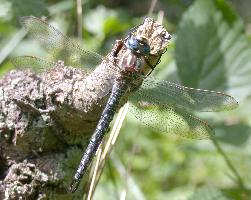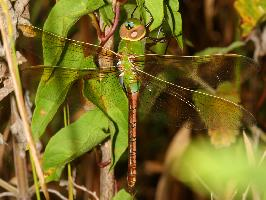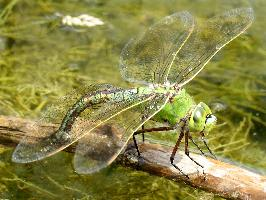
Greutăți și măsuri
| Lungime | de la 54 la 60 mm |
|---|
Descrierea animalului
The Hairy Dragonfly (Brachytron pratense), often known as the Hairy Hawker, is a fascinating species of dragonfly that belongs to the Aeshnidae family. This captivating insect is named for the distinctive fine hairs that cover its thorax, a feature that distinguishes it from other dragonflies. The Hairy Dragonfly is a creature of both beauty and intrigue, playing a significant role in the ecosystems it inhabits.Physically, the Hairy Dragonfly is relatively small compared to other members of the Aeshnidae family, typically measuring between 63 to 70 millimeters in length. Its body is slender and adorned with a unique color pattern that serves as camouflage among the vegetation of its natural habitat. The base color of its body is generally dark, with shades of green and blue providing a striking contrast. The male Hairy Dragonfly is particularly noted for its bright blue abdomen, which is segmented and marked with a series of black triangles along the dorsal side. The female, on the other hand, showcases a more subdued coloration, with greenish hues dominating.
One of the most distinctive features of the Hairy Dragonfly, apart from the fine hairs on its thorax, is its wings. The wings are clear, with a span that can reach up to 70 millimeters, and are characterized by a pterostigma (colored, thickened cell found near the leading edge of each wing) that is brownish in color and helps in stabilizing the dragonfly during flight. The wings are held away from the body when at rest, a posture that is typical of dragonflies.
The Hairy Dragonfly is predominantly found in various parts of Europe and Asia, particularly thriving in temperate regions. Its preferred habitats are shallow, still, or slow-flowing water bodies surrounded by dense vegetation. Such environments include marshes, ponds, and canals, where the larvae, known as nymphs, can find ample food and protection. The nymph stage is aquatic, and the dragonfly spends the first few years of its life in water before emerging as an adult.
The adult Hairy Dragonfly has a relatively short flight season, typically from late April to early July, during which mating and feeding are its primary activities. The diet of the Hairy Dragonfly consists mainly of smaller flying insects, which it captures with remarkable speed and agility in mid-air. This predatory behavior plays a crucial role in controlling the populations of these smaller insects, thereby maintaining the ecological balance within its habitat.
The mating process of the Hairy Dragonfly involves a unique aerial display, after which the female lays her eggs in the stems of aquatic plants. The eggs hatch into nymphs, which will then undergo several molts, growing larger with each stage, until they are ready to emerge as adults and continue the cycle.
In conclusion, the Hairy Dragonfly (Brachytron pratense) is a remarkable species, not only for its distinctive appearance but also for its role in the ecosystem. Its presence indicates the health of wetland habitats, making it an important species for biodiversity. Despite its beauty and ecological importance, the Hairy Dragonfly faces threats from habitat loss and pollution, emphasizing the need for conservation efforts to ensure its survival and the health of the ecosystems it supports.
Animale similare
Fotografii noi cu animale
Top 10 animale
- Dolphin gull (Leucophaeus scoresbii)
- Diana monkey (Cercopithecus diana)
- Moustached guenon (Cercopithecus cephus)
- Greek tortoise (Testudo graeca)
- Stone loach (Barbatula barbatula)
- Galápagos tortoise (Geochelone nigra complex)
- Japanese macaque (Macaca fuscata)
- Russian tortoise (Testudo horsfieldii)
- Common flying dragon (Draco volans)
- Galápagos penguin (Spheniscus mendiculus)

